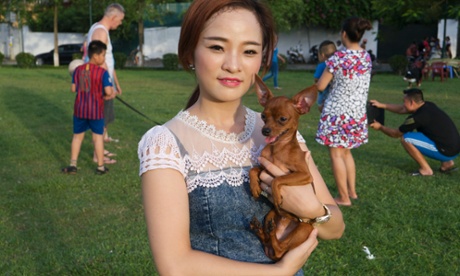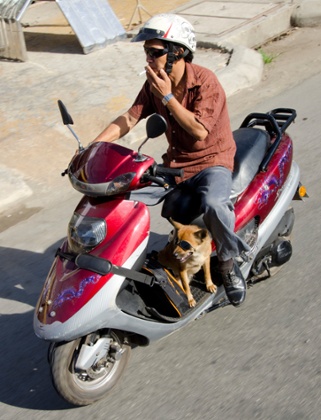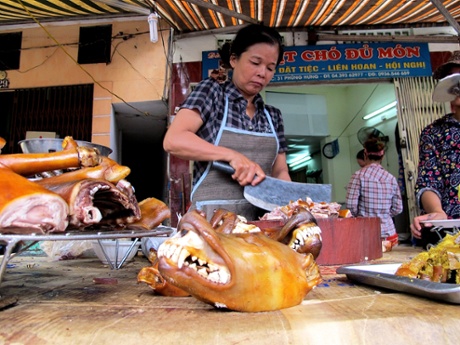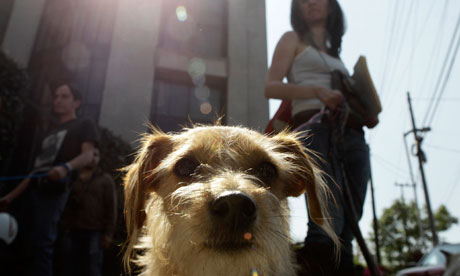
A woman with her pet dog at a park in Hanoi’s affluent Tay Ho district. Photograph: Marianne Brown
In the golden light of a late Sunday afternoon, around a dozen people gather with their pet dogs at a small park near a lotus pond in Hanoi’s affluent Tay Ho district. The mood is convivial but there’s one topic that puts people on edge – dog thieves.
“While I was watching the final of the World Cup, our dog was robbed from the yard of the house,” says 40-year-old Hai, who sits in the park with his daughter and a two-month-old doberman puppy.
“There are more and more cases like this because now more people really love dogs, not just for meat like before, now dogs are part of the family,” he says. “The thieves recognise they can make money from it.”
Vietnam’s rapid economic growth has led to an increase in disposable incomes and changing lifestyles. More people are living alone to focus on their career, and want to keep pets for companionship.
Interest in pedigree pets has only emerged in the last few years, says Wayne Capriotti, editor of Vietnam’s first pet magazine Me Thu Cung. “The first pet store opened in Saigon in 2005, before that there was nothing,” he says. “I think there’s about 50 in Saigon now and maybe 20-25 in Hanoi.”
Many dog owners socialise and share information online. One of the most popular on Facebook is the closed group “Hoi Nhung Nguoi Yeu Con Cho Tai Hanoi” , which started in May last year and already has nearly 20,000 members.
“I can find a breeder who would give you any kind of dog,” Capriotti says. “A couple of years ago they wouldn’t know anything.”
But while the general public are learning more about pedigree breeds, so too are the thieves, he says. “They know a pure-bred rottweiler is worth a lot of money. They’re going to sell it to another pet owner, or ask for ransom.”
Vietnam is well known as a nation of dog eaters, especially in the North. Dog meat is usually consumed at certain times of the lunar month for good luck. Activists estimate around 5 million animals are slaughtered for the trade every year. Thefts of mongrels for the meat industry are widely covered in the local media, often accompanied by calls for stricter penalties for dog thieves. Earlier this month a 22-year-old man was jailed for a year after he was caught stealing six dogs.
Dog thefts for meat and for ransom are connected, says Le Duc Chinh, Vietnam coordinator of the Asia Canine Protection Alliance. “In my opinion, the crime is related to thefts for meat. It could even be the same people,” he says. However, pets stolen for ransom do not garner the same level of attention.
“Since I was appointed, I have not heard any reports about pedigree dogs being stolen by thieves, who then ask for a ransom then return the dog,” says Nguyen Anh Tuan, who was promoted to chief of the district police in Tay Ho last year.
man and dog on scooter in Saigon

A pet dog takes a ride in Saigon. Photograph: Alamy
But dog owners in Hanoi tell a different story. Of 10 people interviewed at the park including Hai, only one said he had never heard of dogs being stolen for ransom. Six said they had close friends whose pet dogs had been stolen, four of which were returned for a ransom.Two others knew about the problem from reading about it on the internet.
When contacted online, four members of the Hanoi dog lover’s club on Facebook said their pets had been stolen in the last month and returned for a ransom. None of the dog owners interviewed said they would go to the police if their dogs were stolen because they don’t have proof of ownership.
That is a big part of the problem, Capriotti says. Certificates of ownership are only available if the owner buys a dog from a breeder recognised by the Vietnam Kennel Association or if the animal has been brought in from overseas.
“Most pet stores that sell live animals do not even give you a receipt for purchase – they buy from anonymous dog traders,” Capriotti says. “The government requests all home owners to register their dogs, but that rarely happens.”
Only a few vets offer microchipping and there’s no national programme. There is also no pet insurance available from local providers in Vietnam.
Thefts are so common that there is an established protocol for finding your dog if it’s stolen, says jewellery designer Hisui Kobayashi, whose husky Kuma was snatched near her home in Tay Ho in April. “I just really wanted to get her back so I put the ransom really high at [$750],” she says. “If I went through the normal process, which is what a lot of local people were telling me to do, I probably would have been able to get her back for [$250].”
The “normal process” is distributing posters with a photograph of your dog and your telephone number in the neighbourhood. “They [the thieves] usually come back after a week and you negotiate how much money you need to pay to get your dog,” she says.
There are other avenues for finding stolen dogs. I visited a pet shop on Bach Mai street in the city centre saying I was looking for a dog that had been stolen the day before. The proprietor’s father told me many people come to the shop looking for lost dogs, producing four “lost” posters to illustrate his point.
“Vendors come to the shop selling dogs, but they don’t have papers so we don’t know if they are stolen or not,” he said, adding that the shop buys the dogs for between $50 and $100 each.

Dog meat stall in Hanoi A dog meat stall in Hanoi’s Old Quarter. Photograph: Marianne Brown
He told me to leave my contact details and a photograph of the dog so they could look for it in exchange for a fee. Gesturing to an aged cocker spaniel in a cage, he said the shop would charge $400 to return a dog like this to its owner if the animal had been stolen.
“The owner loves the dog so the ransom is higher than buying a new one,“ he says.
Just down the road on Hong Mai street, a young man sits next to some fluffy white puppies gnawing the bars of their cage. He asks for detailed information about the dog I’m looking for, including the sex and where I bought it. For a fee of around $1,000 he says he can find the dog. Many people on the street offer “middleman” services like himself, he adds, but insists he does the best job.
Police chief Tuan says if a dog is stolen, the owner should report it immediately to the police. “If they don’t report, how can we help?” he says.
Dog owner Hai thinks the government should do more to help people protect their pets. In the meantime, he has his own solution to the problem. “Now I lock her in a big iron cage at night,” he says. “That way I know she’s safe.”
